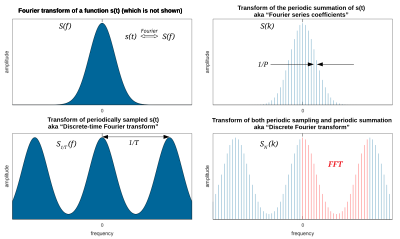Periodic summation
In signal processing, any periodic function with period P can be represented by a summation of an infinite number of instances of an aperiodic function , that are offset by integer multiples of P. This representation is called periodic summation:

When is alternatively represented as a complex Fourier series, the Fourier coefficients are proportional to the values (or "samples") of the continuous Fourier transform, at intervals of 1/P.[1][2] That identity is a form of the Poisson summation formula. Similarly, a Fourier series whose coefficients are samples of at constant intervals (T) is equivalent to a periodic summation of which is known as a discrete-time Fourier transform.
The periodic summation of a Dirac delta function is the Dirac comb. Likewise, the periodic summation of an integrable function is its convolution with the Dirac comb.
Quotient space as domain[]
If a periodic function is represented using the quotient space domain then one can write
instead. The arguments of are equivalence classes of real numbers that share the same fractional part when divided by .
Citations[]
- ^ Pinsky, Mark (2001). Introduction to Fourier Analysis and Wavelets. Brooks/Cole. ISBN 978-0534376604.
- ^ Zygmund, Antoni (1988). Trigonometric Series (2nd ed.). Cambridge University Press. ISBN 978-0521358859.
See also[]
- Dirac comb
- Circular convolution
- Discrete-time Fourier transform
- Functions and mappings
- Signal processing









